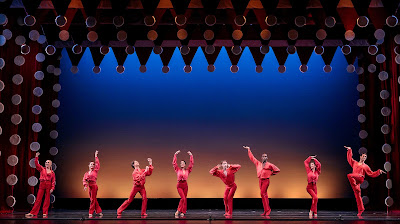 |
| Smuin Contemporary Ballet in Amy Seiwert's The Twelve Days of Christmas Photo Chris Hardy |
The Christmas Ballet
Blue Shield of California Theater at YBCA, San Francisco
December 20, 2022
Holiday performance in the Bay Area has always been vast and varied. A true myriad of productions, styles, genres and disciplines – something for everyone and for every taste. While the last couple of years have certainly been tough for the theater, as we close 2022, most of those holiday performance traditions are back in full force, and many are stronger than ever.
One that is experiencing a renewed energy and vigor is Smuin’s The Christmas Ballet, currently finishing out its December engagement at YBCA. The company looks very strong. The variations that Artistic Director Celia Fushille and her artistic team selected for the two halves – The Classical Christmas and The Cool Christmas - are fun, vibrant and very fresh, be they a new premiere or a longtime favorite choreographed by the company’s founder Michael Smuin. I’ve seen The Christmas Ballet on many occasions, but this was my first time at the LGBTQ+ celebratory night (the third one Smuin has hosted). A fabulous emcee guided us through the evening, which benefitted several local LGBTQ+ organizations. The runner-up for season 14 of RuPaul’s Drag Race, Lady Camden, aka former Smuin company artist Rex Wheeler, not only welcomed us into the space, but also made a couple of amazing appearances later in the show.
In honor of the LGBTQ+ community, the rainbow flag, or pride flag was heartily saluted throughout. Dancers in Smuin’s Veni, Veni, Emmanuel, a choreographic statement of gorgeous simplicity, donned colorful sashes offsetting their stark white costuming. Pretty Paper replaced the traditional one-hued ribbon with a popping rainbow one, and in the hilarious Santa Baby, led by Lady Camden at this performance, the famous boa boasted every color one could imagine. But costuming and design weren’t the only ways the Smuin team thought about this particular program. There were also notable changes in assigned casting. Instead of adhering to traditional ballet gender norms, Smuin changed up roles and pairings in several chapters. The result was just beautiful.
Many of my favorite excerpts in year’s past were back for 2022’s bill, including Act I’s Zither Carol (Smuin). There is much to love in this delicate, ethereal solo, danced at this performance by Claire Buehler. It has everything wonderful that is classical ballet – superb balance, luscious turns and juicy extensions. Choreographer and former Smuin dancer Nicole Haskins had several pieces on the program, including Fantasia and the world premiere of Peaceful Prayer. Like its musical counterpart, the former deliciously lived outside the rules, moving from light, delicate motions to sprightly, upbeat petit allegro. The latter was an emotive, swirling duet by Terez Dean Orr and Anthony Cannarella. Passionate and elastic, it felt like Orr rarely touched the ground. The other world premiere for 2022 was created by Smuin alum Amy Seiwert, The Twelve Days of Christmas - a genius mash-up of the titular song, Rudolph the Red-Nosed Reindeer, Deck the Halls, and surprisingly, even Toto’s 1982 hit, Africa. The visual landscape provided a perfect mix of dance and gesture, humor and nostalgia.
One thing I look forward to in The Christmas Ballet is the joyous presence of percussive dance, a form that doesn’t get its due on the concert stage in my opinion. Peppy Celtic footwork offset a calm upper body in The Gloucestershire Wassail and Act II’s Bells of Dublin. Waltz clog pulled up to the table in Droopy Little Christmas Tree (all three by Smuin). And Tessa Barbour’s duet It’s Beginning to Look a Lot Like Christmas was so much fun. The tap prowess of Cannarella and Ricardo Dyer was undeniable and impeccable – from beginning to end, every beat, so precise and crisp.
















